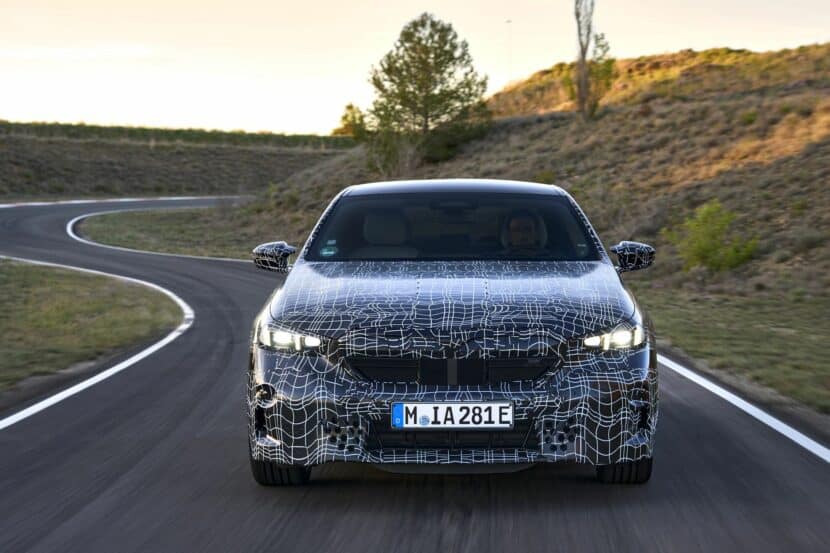The automotive part of the internet has been flooded recently with reviews and opinions about the new 2025 BMW M5, the G90, a real heavy-hitter with way more power and torque than any M5 that came before it. However, because it’s a plug-in hybrid that weighs over 1,000 pounds more than the F90 it replaces, it isn’t any quicker to accelerate than its predecessor—it’s actually slower. With an official weight of 5,390 pounds (2,445 kilograms), it is heavier than a G05 X5 with either the 50e plug-in hybrid or M60i V8 powertrains, as well as the same versions of the G70 7 Series. It’s one of the heaviest BMWs you can buy today, even heavier than the manufacturer’s already pretty hefty EVs, including the i5 M60, which weighs 5,081 lbs (2,305 kg).
The Obvious Downsides of Weight

More mass is the enemy of all things holy to driving enthusiasts. It makes cars more cumbersome, and the weight transfer from side to side is more violent and difficult to control. Braking and turn-in are also affected, and no matter how brilliant BMW’s engineers have proven to be in masking their vehicles’ weight, there’s only so much they can do.
This makes us wonder whether the i5 M60 may be the better, more capable performance car around a twisty road. It has a lot going for it, weighing about 300 pounds less than the M5 and a heavy battery pack placed in between its axles and very low in the vehicle—it surely has a lower center of gravity and less weight in front of its axles, so its electronics need to do less behind-the-scenes magic to keep the electric 5 in check through the twisties.
Different Weight Distribution Between M5 and i5 M60

With more weight on the front axle than the rear, the new M5 doesn’t have the BMW 50/50 weight distribution. The weight distribution depends on the specs of the car. It starts with 54% on the front-axle and goes may be down to 52%. For example, the BMW M5 with a trailer hook has less weight on the front-axle. Also, the panoramic sunroof has impact on the weight distribution. The i5 M60, on the other hand, is much closer to being evenly balanced, with 50.1% over the front and 49.9% over the rear.
With 601 horsepower and 604 pound-feet (800 Nm) on tap from its two electric motors, the i5 M60 needs 3.6 seconds to sprint to 60 mph. Its electronically-limited top speed of 143 mph (230 km/h) means a G30 320d with 190 horsepower will leave it behind in an autobahn dash—the diesel won’t match its acceleration, but it will eventually catch up, overtake and start pulling on the i5 with its slightly higher top speed.
The M5, on the other hand, has 717 horsepower and 737 pound-feet of torque, which come courtesy of a 585 hp V8 and a 197 hp electric motor. It should hit sixty in 3.4 seconds, and with the optional M Driver’s package, it can reach 190 mph (305 km/h). The i5 M60 is therefore slower than the M5 in a straight line, but through the corners it might not only be able to keep up, it might also be a bit quicker.
It would be very interesting to see a touge race between these two vehicles and see how they compare on a twisty road. The result might be surprising with the i5’s lower weight and ability to deliver all its torque instantly, unlike the M5, which still needs to build boost to feed its two turbochargers.
G90 BMW M5 On Track

We’ve had a chance to drive the G90 around a track, and we were certainly impressed. Unsurprisingly, BMW has somehow managed to mask the elephant in the room somehow, making the car feel lighter than it actually is and more eager to turn in than you would expect. This is done through excellent calibration of all the controls, the powertrain and the electronic aids, as well as its excellently judged suspension and the use of rear-wheel steering.
The G90 does have a surprising amount of body roll through the corners, though, and when braking for tight corners at high speeds, you really feel the car’s heft—it needs a bit more braking distance than the F90, and it seems to dive a bit more under braking too. If you’re switching from an F90 to a G90 and you used to do a lot of track days in it, you will have to get used to initiate braking earlier in the new car just because it’s so much heavier and it needs a bit more distance to stop.

Driving the i5 M60 around a track will not seem as fun since it lacks the drama of eight cylinders force-fed by twin-turbochargers, but that will allow you to concentrate more on the handling. Not having to contend with spooling up turbos, power bands and changing gears makes the way the car handles the main point of focus, and the i5 feels really good around corners, so it will not disappoint.
The fact that we even considered comparing an i5 to an M5 is a testament to how good the electric version of the 5 Series is and how the extra weight affects the M5. The latter will still be the enthusiast’s choice, since it still has a fantastic combustion engine under the hood that would still make it the favorite even if the i5 had superior acceleration.
Which flavor of 5 Series performance variant would you consider now that the M5 has become so heavy? Does it make the i5 M60 more appealing and are you looking forward to even more powerful EVs with BMW M and Mercedes AMG models going plug-in hybrid? Let us know in the comments.





































































